Being immersed in the fitness industry provides me with a ton of different opportunities to experience different techniques, methodologies, and products. I recently had the privilege of a...
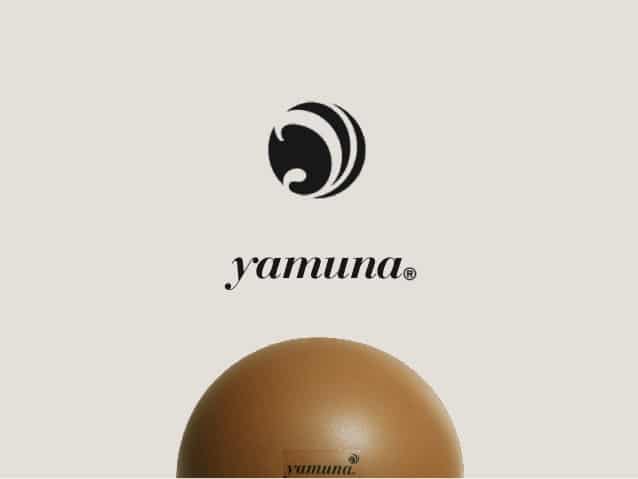

Being immersed in the fitness industry provides me with a ton of different opportunities to experience different techniques, methodologies, and products. I recently had the privilege of a...
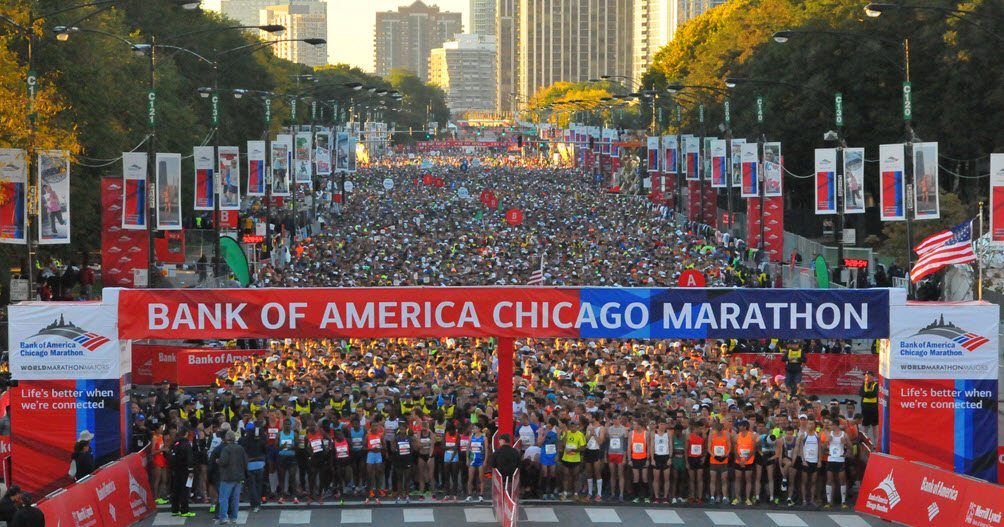
Leading up to the Chicago Marathon 2016 The Chicago Marathon provides an excellent course, plenty of support and, for me, a chance to visit home for a few days. It was no different for me this...
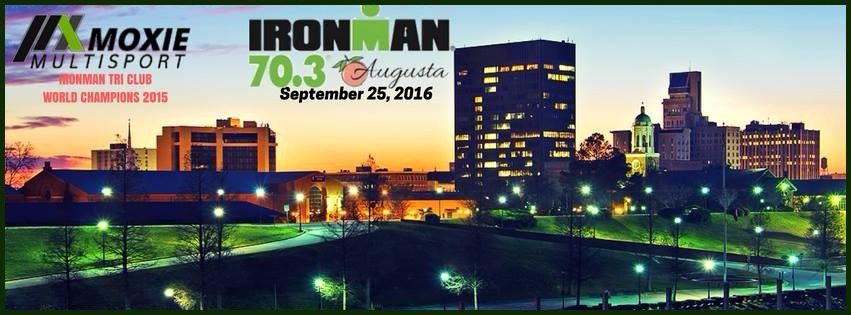
September 25 was going to be my day. The Ironman Augusta 70.3 triathlon was finally here. The race I had been training so hard for on one of my favorite courses. It was four-and-a-half months...
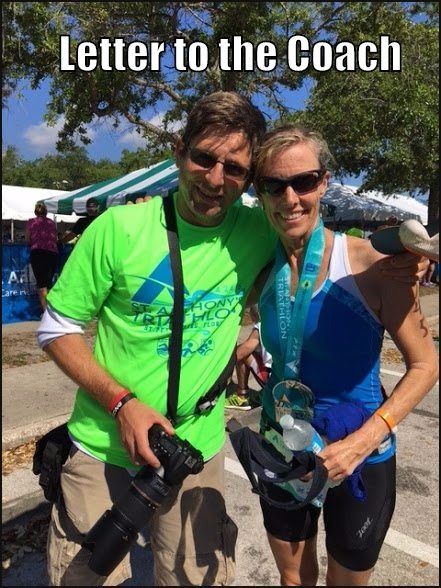
I have been an endurance coach for some time now. Once in a while, I receive an email from a client which chokes me up with pride. Today, I received one of those letters, so instead of sharing it...
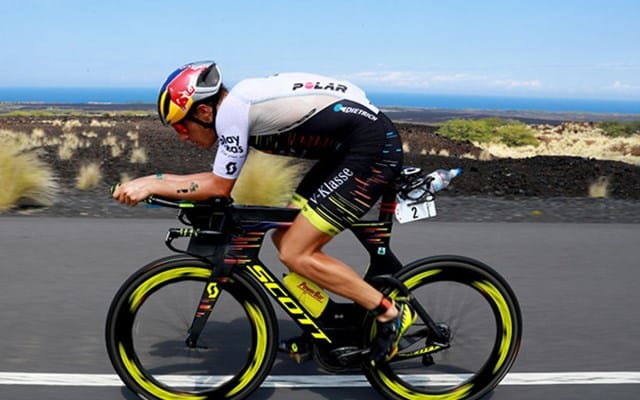
I found when looking for ways to get faster on the bike, is that there is so much information, from different coaches and experts, that it can be confusing and overwhelming. Personally, I...
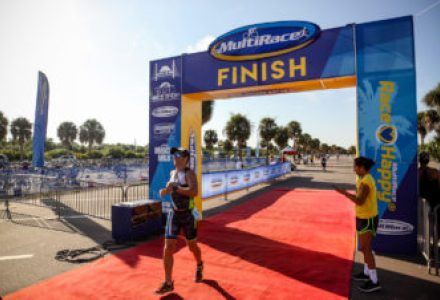
The previous post was a review of the FD3 Triathlon Series as if it was a product. Below you will find a more detailed account of my personal experiences during the race. Let me know in the...
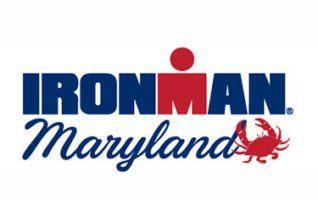
I signed up for Ironman Maryland initially due to the reviews that said it was fast, and beautiful. Jaime started it with all the hype about it being a fast flat bike course because she despises hills, even though most of her fastest bike splits came on hilly courses. Touché. So, last year after a lot of pestering Pete, we registered and the training began. Pete, Jaime and I have been training together for about 4 years, ever since I decided to get serious about triathlon. We ingeniously started calling ourselves “PB&J”. Get it? Peanut Butter and Jelly or Pete, Brad & Jaime.
Interesting enough though, I really wanted a sub 12-hour Ironman and Jaime was shooting for a sub-13, so as much as we enjoy training together we actually ended up going our own ways. I started training at Tribal Multisport with Coach Jon Noland, and Jaime trained with Personal trainer and elite athlete Kenneth Jones.
We made all the arrangements well in advance. We had hotel reservations at the host hotel, restaurant reservations, tri-bike transport was scheduled, flights were booked and cars were rented well in advance.
We talked constantly throughout the months, confirming our plans, comparing training schedules and every once in a while, we actually did get together to train. PB&J looked strong and ready to face IRONMAN Maryland together. Unfortunately, in September, Pete ended up injuring his Achilles’ tendon and after a lot of conjecture decided it wasn’t in the cards for him this year. I told him, it would better to live and race another day than to permanently hurt himself.
We departed for the race on Wednesday, September 30 completely anxious and excited. We headed to Tampa International Airport, for an uneventful flight into Baltimore-Washington Airport. Within a half hour we were in our Jeep Compass rental and headed up Rte 50 in Maryland.
We stopped for a quick lunch at Carmine’s Pizza to carb load with pizza and salad and just as we are about to pull out of our parking space and back into traffic, Jamie’s phone rings. Ed, a friend and first time Ironman athlete, called and tells us the race has been cancelled. I could hear Jamie’s voice say, “Uh say that again…wait…wait. Let me put you on speaker.” A deep Jersey accent comes from her speaker and says “They cancelled the race.” Really? This early.
The last time WTC cancelled a race it was in Lake Tahoe and the athletes were in their wetsuits ready to jump in. They waited that long and now, 3 days before the race they were cancelling it.
We jumped on Facebook, and the IRONMAN Maryland site and were met with the validation that WTC had indeed cancelled the race. It turned out the immediate threat from Hurricane Joaquin was dire and it was in their best interest to keep the athletes, volunteers, race staff and spectators safe. Not to mention, there was already four inches of water already on the course.
We got somewhat lucky. We were able to find a flight home that night, and the hotel did not charge us a night for cancelling so late. Unfortunately, the flight back cost us just as much as the full round trip, and because we pre-paid the car we couldn’t get that back.
WTC anticipated rescheduling but couldn’t give the athletes a final decision until the following Tuesday. The wait was hard. What do you do? Do you keep tapering? Do call it a season? There was nothing to do but wait.
Late Monday night an email hit my account stating that the race was back on and it would be held on October 17th as predicted. All I can think of was “Here we go again.” What if the weather was bad again? Would we spend even more money just to go through another disappointment?
Coach Jon, put a schedule together of low duration, high intensity workouts to keep my body from degrading fitness for the next week, and I managed to squeeze out a 17 mile run with a client that felt awesome the Sunday prior. The weather outlook was good, cold, but decent. As the days passed, the forecast kept getting colder and windier, but no precipitation was even close.
This time it was going to happen.
From Tuesday on, Jamie, myself and another training partner of hers, Hunter, had a group text as we kept planning our trip. We found decent round-trip flights, Hunter found a rental house, and I again reserved a car. Of course this time I bought the trip insurance as well, which, of course, I did not need.

The View from our DC Hotel
And on October 14th, we took off for the second time from Tampa and arrived, this time at National Airport in DC. We spent a great night at the Residence Inn in Pentagon City before heading out to Cambridge the next day.
As I drove though the rural part of Cambridge and into the long drive way of our rental home, I was surprisingly calm. Subconsciously, I think I just didn’t want to get my hopes up, but my heart rate did jump at the surprise I felt pulling into the gravel drive way. It was gorgeous!
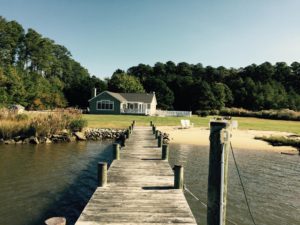
Our Cambridge Ironman HQ
There stood a modest one-story ranch home, but on a huge amount of acreage that backed up to a lake. It had it’s own dock, fire pit, pool, and a beautiful deck. Inside it was an open floor plan with a dining-kitchen area, huge great room and three good size bedrooms. It was decorated modestly, with wood floors and a kind of rural, yet updated and upscale charm to it. All of the appliances were current models in the kitchen and baths with flat screens in each room, and a large one, in the great room, a fireplace and gigantic sectional couch that all of us could have slept on.
What was even luckier was that it wasn’t only Hunter, Jamie and myself, but Kenneth and his parents, so by sharing it, the cost was not even half of what we would have to pay for the hotel.
I also have to say, that Ken’s parents, treated all of us like we were their kids. His Mom, Lucy, cooked and cleaned for us, and his Dad, Phil, grilled, shopped and chauffeured us around to make sure we were at the right place at the right time. It was like Ken, outsourced his parents to us. Of course that wasn’t the case. It seemed like they genuinely loved doing it.
It came time to travel over to transition and pick up our bikes, and then head to Ironman Village to check-in.
We reached transition and since Hunter and Ken already had their bikes, because Ken and his parents drove them up, they headed out to check out the swim start while Jamie and I talked to Tri-bike transport. Jamie’s bike was already in the rack, but unfortunately, mine was not to be found. My stomach took a little turn when Drew, from TBT, said I wasn’t on the list to have my bike at the race.
Luckily, he said that my bike was in the truck, but it was with the bikes that were sectioned off for the athletes that were not going to be returning.
I headed over to the transition area to scope it out and then took a quick peek at the swim start and at that point, my anxiety started to increase. This was happening. There no “ands”, “ifs or “buts”. I was going to be racing my third Ironman.

Ironman village was exactly as it was for every other Ironman and Ironman 70.3 I have raced except, because they were not able to keep all of the original volunteers procured, it was a lot slower checking in. We waited in line for close to two hours before we finally made it under the tent to pick up our packets and swag.
When we finally got through that line, we contemplated going into the Ironman store, but the line to check-out was just as long and we still wanted to get a quick workout in. In every Ironman store I have been in, for every race, the cashiers, (bless their hearts) are always so slow that you know if you do get in that line, it is going to be a lot of time.
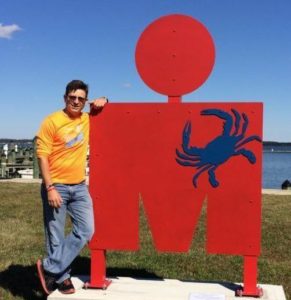
We headed back, and unfortunately, I had yet to receive a call from Drew to tell me that he was able to dig out my bike, so the others headed out on their bikes and I decided I would just work a little while I waited for his call. At 4pm, I did receive the call and 45 minutes later I was back at the house with my bike.
Leading up to the Saturday morning, was pretty much the same as any other long race. Putting gear bags together, going over transition and nutrition plans, and quick workouts in all three events. These were basically just to make sure everything was in working order.

The Goof, Ken, Hunter, Jaime & Ed before a swim workout
Did I mention Thursday night we had a campfire and made s’mores? Yeah, we did that too.
I was pretty shocked at how well I slept Friday night. We had all turned in quite early, in anticipation of not being able to sleep, but I drifted off pretty fast and slept until the 4:00am alarm woke me up. None of us were in a rush as we all felt pretty prepared, and the outside temperature was only in the upper 30s. I dressed, ate and leisurely grabbed my morning bag and we headed out into the darkness.
Leaving the house I had yet to really feel nervous, but as soon as we pulled up to transition, I felt a pressure in my chest. My heart started to beat so hard, I thought it was going to crack through my rib cage and take off on me.
I looked over at Jamie, and she looked back and said,”Sh*t just got real.”
After outfitting my bike with my nutrition and helmet, I took a walk over to the actual swim start line and looked over the water. Waves didn’t seem that bad, but the water was far from calm. I could feel the wind on my skin even through the wetsuit. Luckily, while it was 38 degrees outside, but the water it was 63. That was going to work in our favor, as it was actually going to feel warmer in the water.
Around 6:40, Jamie, Hunter, Ed and I were all hanging out trying to keep warm and maintain a positive mental attitude, when the speaker echoed our announcer’s voice. The safety team had stated that the winds were causing a lot of churning in the water, so the boats and paddle boards could not take their places on the course. The solution was to shorten the course to 1.2 miles.
I should have been really excited about this, as the swim is my weakest event, but I wasn’t. I was actually a little upset not only because I wanted to prove to myself I could get out of the water within my goal, but also for Ed and Hunter as this was their first full distance Ironman.
What else could happen? First they postpone the race, and now they shorten the course. This race just seemed cursed.
That was not the end of the story. Around 7:10, an announcement was made that, the winds had died just a little and would be enough to get most of the swim in. We would do the swim, but we would be about 800 meters short.
Things just looked better. I felt redeemed and a positive relief flowed through me for about half a second. I still had to get passed the swim. If you remember from my post about my last Ironman, I was the last one out of the water to be able to cross the line. I worked a lot harder on my swim this training cycle, now I would have to prove it.
At 7:30 we lined up according to how much time we thought it would take us to swim the full 2.4 miles. I lined up at the behind the 1:30 sign and after waiting another 20 minutes to get through the line, it was my turn to jump in.
The water still frigid enough to shock my body a little, but my adrenaline kept me warm. I immediately headed to the first buoy where we would turn right and then head in triangular pattern.
I felt really good during the first lap. For the first time in an Ironman race I was actually passing people and it felt amazing. I still felt pretty strong as I made the turn for the second lap, but I did slow down a bit.
As much as I thought I loved my long sleeve wet suit, I didn’t have the mobility in my arms, that I developed during training, and I had to strain to lift my arm into a streamline position. I listened to myself hypothesize about it and I thought, “Am I really thinking this? Did I really become a decent enough swimmer to even contemplate it?”
On the second lap, the wind picked up again and I thought I was swimming in my washing machine. I got tossed around and the effort level increased. I did end up breast stroking intermittently for a few minutes to catch my breath and realign my siting, but I continued. My habit of zig zagging didn’t show up until the last straight away while I was trying to sight on the finish. The waves were pushing me in the wrong direction, but my sighting was able to put me back on a good path. I jumped out of the water and ran towards the timing mats, and as I crossed I looked down at my watch – 1:10.
1:10? Really? I had to double check it twice. If I added the 800 meters back on I would have finished around 1:25-1:30 which, was my goal.
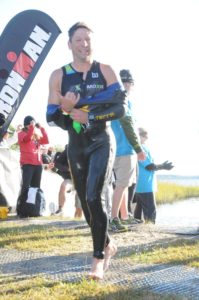
I was so excited I sprinted to the strippers, but for some reason they didn’t help. My wet suit would just not come off of me and when it did, oh man, did I feel the weather. The wind hit me, and my soaked tri kit, like a brick wall.
I headed into the changing tent and dawned a bike kit, arm warmers, a gator neck, and gloves. By the time I added my helmet I looked like a Tri Ninja.

Ed gave us a quick rundown of the bike course the night before, as he came up earlier in the year and actually trained on it. He explained how the course was an oval and we would probably have a head wind on one of the shorter sides and away or back to transition. This would account for two blocks of 12 miles since we had two laps. I was ok with it. I would just turtle for those 24 miles. (This is a technique keeping your head down and allowing your back to come up like a turtle shell to be as aerodynamic as possible.) The rest of it my plan was to stick to 75-80% of my functional threshold power(FTP) as possible. In training that proved to be right around 20 miles per hour which should get me back to transition in 5:35, and then taking account for the wind, sub 6 hours.
No such luck. I have never ever been on a bike course where the majority of the turns were to the right, and kept being hit by the shear force of a 33 mph head wind.
I wish that were the only factor that slowed me down.
I knew because of the temperature that I would not want to drink, but due to the fact my calories were mostly in my bottles, I would have to. What I didn’t count on was that I would have to stop at a portlet every 10-15 miles to urinate. I am just not die-hard enough to urinate while I am on the bike, and we were specifically told that if athletes were caught relieving ourselves outside of designated facilities they would be DQed. That slowed me down.
From mile 40 to 50 we were all riding on the shoulder of the road, into the wind. Directly to the right of the white line were slowing rickets with very small spaces in between them. They seemed a little dangerous, so everyone was either on the right of them, or on the left and swerving to the right when traffic would come from behind.
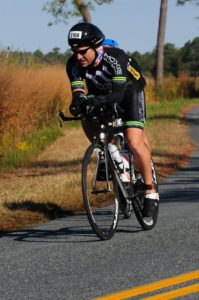
I was in aero, with my head down, when I saw a tire in front of me, so I yelled “On your left.” The wind was so loud the person in front of me, wearing a “This Guy Needs A Beer” jersey, could not hear me. As I slowed down to keep enough bike lengths between us to satisfy the drafting rule, I noticed a motorcycle next to me. It was an official.
He pulls out a memo pad and yells to me, “At the next penalty box, tell them you have blue card.” Well, I wasn’t going to start arguing while I was the bike, so I nodded.
At the mile 56 aid station there was a penalty box, so like a good athlete I did what I was told, and so did the other seven athletes that came in behind me. There we all were. Eight, age group, athletes standing stretching while we waited for our five minutes to be up. I am all for rules, order and safety , but it’s a little ridiculous when there are eight people in the penalty box all caught doing the same thing on the same stretch of road. As this was my 3.4 hour mark on the bike, I asked the volunteer who had to time the penalties how many he had so far. He kind of smirked and said it had to be over one hundred.
At that point I just had to laugh. I got back on my bike and continued trudging through the wind.
Ten miles later, a slow burn started aching my legs. I didn’t understand it. My cadence was up, but no matter how high I shifted, I felt like my effort level was increasing. Then I heard what was a metal grinding. Yep, you guessed it. A flat in my rear tire. These were brand new tubular tires, I had installed just for the race, and now I punctured them. I had a bottle of pit stop in my jersey, so it was only a couple of minutes before I was back on my bike. With Pit Stop, I didn’t even have to take the tire off, just empty the contents of the bottle into the tire and go.
Luckily, I didn’t have to stop nearly as much the second loop as I did the first to urinate, so I picked up a little bit of time, but while keeping to my FTP goals, I could barely get above 17 mph. It felt slow and torturous.
The left turn for the last 12 miles came and I thought maybe we would catch a break and as I passed the last aid station one of the volunteers yelled, “Your on your way back, no more wind!”
He lied.
The whole way back to transition, the wind hit us and kept our pace to a slow 16-17 mph.

As I dismounted my bike, I could feel not feel my toes or my hands, and I was just frigid. I tried to take off my bike gear, and it was extremely difficult. I felt like I did, during the last ironman at mile 13 of the run and I hadn’t even started the run yet.
The grumbles in the changing tent were all the same. The bike was windy, it was tough and it sucked, but it was over. A few of the guys who competed in last year’s event said they were over an hour slower than the previous year. That actually made me feel a little better.
I have a saying I give to my athletes when they start to walk or I find them giving up on themselves. “The mind will quit 100 times before the body does.”
For a nanosecond a thought went through my head. “I already did two of these, I don’t need to prove anything to anybody. Forget this.” Then the next nanosecond went by with my inner dialogue that said “Who are you kidding Minus? You know you are going to finish if you have to crawl across that finish line. You never quit anything in your life, what makes you think your going to do it now?” The last words that echoed in my voice were that of my coach Jon Noland. “Embrace the Suck.”
I changed the best I could with numb fingers and toes and started the run. (I found out later I spent over 20 minutes in T2. It sure didn’t feel that long. I must have taken a nap.)
The first two miles felt a little slow, then at mile three it was like the pearly gates opened up. My legs transitioned into a good running form and I took off. I felt amazing.
I kept to my strategy of walking through the water stops, which during an Ironman is every mile, but they are only a few yards long, unlike those at a major marathon, where the distance could exceed a hundred yards.
At mile seven I actually felt a side stitch which hasn’t happened in a race in years. Luckily, I still had my wits about me. What is the cause, or better yet, what is absent from my body that would possibly cause a stitch? Potassium. Wouldn’t you know it but an aid station was just fifty meters ahead of me, so I grabbed a banana. Within the next quarter mile, the stitch was gone, so I picked up speed again.
The course was two-and-a-half loops that took us from transition through a residential neighborhood, around a park, back through the neighborhood passed transition, into downtown Cambridge where it either started again, or headed to Ironman Village and Finish line.
We had been told that Cambridge was supportive of the race and even in these cold temperatures, the town was out in droves.
Along the route there were kids on their lawns cheering, a dancing banana, residents on lawn chairs, and local bands playing outside their homes. While running through downtown people were outside the bars drinking and cheering every athlete on as they passed. It was just spectacular.
I found Jamie ahead of me around mile 5 and we ended up passing each other three more times. Each time I was getting closer and closer to her. I had hoped to get closer, but in the end she did end up crossing about three minutes ahead of me.
I never ran over 90% of the run during an Ironman before. This time the only time I walked was through water stops and only stopped twice to use the portlet. Granted it was not extremely fast, but it was still over twenty minutes faster than my best Ironman.
My legs at mile twenty were very heavy and this was the half lap and the last time I would have to turn left after downtown Cambridge. I kept going, and didn’t stop but it was getting quite dark to a point where there was a portion of road where I couldn’t see my hand in front of my face. I just kept going.
The thing I just kept thinking in my head was one day, I would finish an Ironman and it would still be daylight.
I came out of downtown Cambridge and made the right towards the chute. I heard the announcer call my name and as I saw the arch of the finish, I wondered if I had it in me.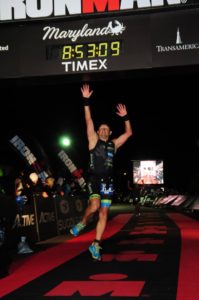
I ran just a little faster and jumped up, caught a little air and touched the arch. I was an Ironman. Again.
My finishing time was 13:08:53 which was actually and hour and forty-six minutes faster than my best Ironman, but if I kept the same pace on the swim, I calculated I would probably have crossed about 20 minutes later which would have given me a ninety minute personal record. In those conditions, I‘ll take it.
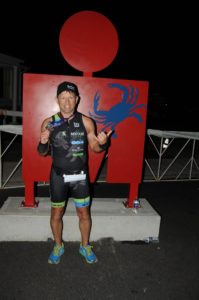
Of course I did not do this alone. I have to thank my coach, Jon Noland for training me (coaches need coaches too), the athletes at Tribal Multisport for pushing me further than I thought possible, the Moxie Multisport team for the help with gear, nutrition, and the support to keep me going through the long training period, my travel and housemates, Jamie, Hunter, and Ken for the great time at the house, and for keeping me sane and laughing, Ken’s parents, Phil & Lucy for the race weekend support, and last but never least, Kim for supporting me at home through this third Ironman.
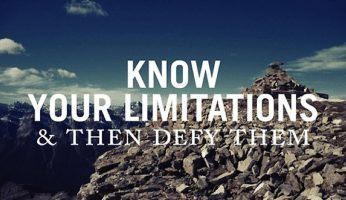
On Tuesdays and/or Thursdays, I will do my best to give one simple fitness, triathlon or running tip, trick or piece of information that will provide some value to in either helping you to become more efficient, prevent injury, increase performance, have more fun or at the minimum give a review of knowledge that might not have crossed your path in a some time.
I find myself observing other runners while running and sometimes just hanging out here in Tampa. Due to the weather here lending itself to year-round training, I have no shortage of material to choose from.
My coaching practice’s number one priority is form, technique and injury prevention, so I routinely use other runners, with my clients to reinforce the form training I have provided. (Sorry, Tampa runners. If you happen to pass by me with a client, most likely you have been observed and surveyed for comparative analysis.)
With all of my observations, the number one issue that I see are runners that sit in the bucket. Of course, the question most people ask is what does sitting in the bucket mean?
Basically, it’s when the glutes(or bum) are not in line with the torso. The body looks like an “L” from the torso to the hamstrings. Natural running which when learned is much easier, more efficient and greatly reduces impact on the joints. The torso hips, glutes and ankles form a straight line.
[table “2” not found /]
The interesting thing is, that running should be instinctual right? Unfortunately, not anymore. Sociological factors have played into our bodies to a point where most Americans, cannot just decide to take up running without going through periods of injury.
For example, sitting at a desk all day will tighten the hip flexors so that it becomes extremely difficult to push the hips under the torso. The same thing is evident for playing video games on the couch for long periods of time.
The figure on the left is actually still a lot better than I have noticed out and about. The torso is still tall and the chest is still has a little bit of lean to it causing forward motion. A lot of runners I notice, sit in the bucket and lean back. What is this doing? Basically, gravity is working against the runner. The objective is forward motion but the glutes and the torso are sitting back, so in essence, the body and gravity are working against itself.
Another perception you will see is the heel strike of the runner. When that heel strikes the ground the impact reverberates all the way from the ankle through the legs, spine, neck shoulders and head. This is where most of the injuries take place.
By simply starting to incorporate, tilting the hips under the torso and leaning from the ankles instead of the waste, the body will start allowing gravity to be used instead of the legs as the sole source of momentum. Suddenly, the feet are striking the ground underneath the center of gravity and only the calf down to the metatarsals absorb the majority of the impact from the ground.
I continue to instill in my clients, running is powered by the core, not the legs. Use gravity as momentum and allow the legs to just go for the ride. To remain consistent, the core must be strengthened and hip flexors stretched to keep the glutes from returning to the bucket.
There are many techniques to help modify the behavior to allow for an efficient, safe and effective change of form. All it takes it the will to want to change and get better and you will.
The #1 tip – get out of the bucket.
Are you running in the bucket?
Did this information shed some light on any area of your running that might be in need of improvement?
Carpe Vitam!
(Seize Life!)

Here it is again, a long time since my last post. Life happens and when it does, watch out. It can really mess up the things you want to do versus the things you must do. I am learning to prioritize what is absolutely important to me versus what is important to everyone else. I hope to soon have that under control, but I digress.
Newton was nice enough to send me both a pair of the Newton Energy and the BOCO. I am reviewing them together since I have found they are the same shoe with the only difference being the BOCO has a tread that is made for the trails and the Energy is made for the road.
To be transparent and honest, I am a certified Newton Coach, so I am a little biased towards Newton. However, I rarely train in Newtons, as running is very personal I have my favorite running shoes to train in.
I do however, love the methodology behind them. For those that do not know, Newton running shoes have 5 lugs in the front of the shoe directly under the ball of the foot. The lugs have a higher or lower profile depending on the shoe.
The lugs serve as a reminder for running form by automatically driving the foot to land on the fore or mid foot, reducing the impact dramatically.
When paired with Newton Natural Run training, the shoe will decrease the effort level of transitioning to a mid or forefoot runner.
In my experience, after the runner has developed the habit, they no longer need to be running in Newtons, but most do not only due to muscle memory, but they also last about 4 times longer than other running shoes.
Prior to the release of the Energy, the core products Newton produced were the Motion, the Isaac, the Gravity and the Distance. These models needed a transition period for the runner to get used to the way the lugs lifted the heel causing some calf soreness.
The Energy now has a lower profile of lug, and a transition plate which actually allows the athlete very tiny transition period, if any, before the comfort of the shoe settles in.
The EVA foam that makes up the sole of the shoe is extremely comfortable and highly accommodating to the road.
The only conflicts I have heard is the heel cup is a little shallow for some, causing some slippage during long runs.
Since one of the core beliefs of natural runners is that shoes should be tied just tight enough to secure the heel, this could be a problem. I have always taught, the athlete needs nothing to support but themselves.
In other words, if the shoe is tied too tight, the shoe ends up supporting the runner. By tying the shoes very light and only tight enough to secure the heel, the feet, the calves, the ankles are strengthened with every activity.
I personally have not found an issue with the heel cup even without the help of a runner’s lace, but I have heard of the issues.
I did get an eleven-mile run on the trails with the Newton BOCO and was I surprised at how well the tread grabbed the terrain. 
The trails I was running were meant for Mountain Bikes and that meant steep climbs and steep downhills and there was not a moment I did not feel secure.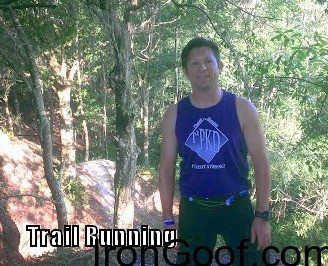
For new runners or for athletes transitioning to more efficient technique, I believe the Energy is the perfect shoe. They are the perfect shoe to transition with before trying one of the core Newton models.
The BOCO is a great trail shoe for anyone wishing to start or continuing a journey into trail running. They are comfortable, supportive and made me feel completely secure on the trails.
That’s my opinion and I am sticking with it. Happy Running!
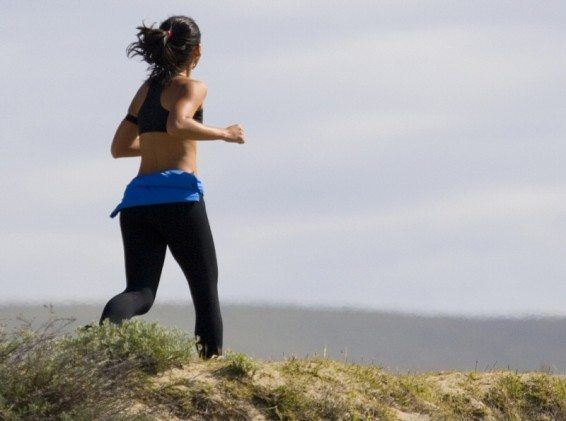
I can hear it now….”Know wonder they call you a Goof…you are crazy.”, “So, if I run slower I will get faster? You are out of your mind.” It was not to long ago I used to think the same thing, but as with everything I post, there are reasons and science to back it up.
Let’s face it, logic would dictate that pushing the pace of your easy days, as close to race pace as possible, would help you get fit faster and help you speed up, right? A lot of coaches, including myself, will tell you to run slow on your easy days, and easy days should be making up anywhere from 50-75% of your weekly mileage.
I have clients continuously asking me, “why are my easy days so slow?” The latest is my famous sit downs with my runners telling them to slow down after examining their data and finding them running tempo speeds during an easy day.
The answer to the question is what Arthur Lydiard and most other coaches would call the aerobic system. The aerobic system, or aerobic development, is the one of the most important fundamentals into unlocking your true potential.
Let us first check the stats on the energy contribution the aerobic system provides for races. As you can in the chart below, even the shorter events like the mile, over 80% of the energy required to run the race is produced via the aerobic system.
Aerobic training is the scientific fact that to move your body at higher intensities, the body needs to break down sugar and convert it to glycogen so it can be used as energy.
The aerobic system plus oxygen starts a chemical reaction known as Aerobic Glycolysis which continuously powers continuous endurance activities. In the aerobic system energy ATP is produced through Pyruvic Acid and Lipid/Protein fragments entering the Kreb Cycle and the Electron Transport Cycle.
Uh…what?
During aerobic respiration (yeah, that’s breathing) the body uses all the oxygen it needs to power the muscles. When you are running in your “aerobic zones” (easy runs), your muscles have enough oxygen to produce all the energy they need to perform.
See? Improving your capacity to transport and efficiently use all the available oxygen to produce energy will enable you to race faster since this makes up 85-99% of the energy needed to race.
Since running easy is aerobic development, what better way is there to train the aerobic system? There is none.
Capillary development – capillaries are the smallest of the body’s blood vessels and they help deliver oxygen and nutrients to the muscle tissues while exporting waste products out. The larger the number of capillaries you have surrounding each muscle fiber, the faster you can transport oxygen and carbohydrates to your muscles.
Aerobic training (easy running) increases the number of capillaries per muscle fiber, thus improving how efficiently you can deliver oxygen and fuel to your working muscles and how quickly they can clear waste products.
Myoglobin is a protein in the muscles that binds the oxygen that enters the muscle fiber. When oxygen becomes limited during intense exercise, myoglobin releases oxygen to the mitochondria to produce more energy.
The more myoglobin you have in the fibers of your muscles, the more oxygen is transported under aerobic stress. Like, uh, during a race. Aerobic training increases the amount of myoglobin you have in your muscle fibers.
Mitochondria are microscopic organelle found in your muscles cells that contribute to the production of ATP (energy). In the presence of oxygen, mitochondria breakdown carbohydrate, fat, and protein into usable energy.
Therefore, the more mitochondria you have, and the greater their density, the more energy you can generate during exercise, which will enable you to run faster and longer.
Aerobic training increases both the number and the size of the mitochondria in your muscle fibers.
Suffice it to say that aerobic development is the single most important factor to long-term development.
Of course, track workouts, VO2 max sessions, tempo runs and cross training will increase your fitness and are still incredibly important to racing faster. However, nothing will help improve continuously like developing the aerobic system.
Aerobic development is dependent upon running in your aerobic zones (for my runners Zones 1-3). This is why running faster on your easy days develop the aerobic system. Once you step out of those aerobic zones, on easy runs you diminish development of your aerobic system, but you also increase the chance for injury. Nope, two negatives do not make a positive in running.
This is one of the single biggest mistakes runners of all experiences make in their training.
As a coach and trainer I have always distinguished myself because I am always able to give my clients and readers the “why”. (Sometimes my clients end up telling me to just shut my mouth. when I am training with them because I am continuously telling them why they are doing each movement of an exercise or workout. I guess it may not be an advantage all the time. Go figure.)
Scientific research has been able to identify how the aerobic system adapts and responds to certain training paces. Physiologically we know:
It is pretty clear now right? Your optimal easy run pace for aerobic development is between 55 and 75 percent of your 5k pace, with the average pace being about 65 percent.
It’s also evident that running faster than 75% of your 5k pace on your long run has very little additional physiological benefit.
In fact, the research indicates that it would be just as advantageous to run slower as it would be to run faster. Running around half of your 5k pace is pretty easy right? Wouldn’t you know it, the evidence is clear that it still provides near optimal aerobic development.
Feel free to let me hear your feedback. I welcome any other case studies, personal experiences and other research as I am always learning. I provide you with the best content I can, but I have an open-mind and know that there may be other research out there that may negate information I post.
~IronGoof
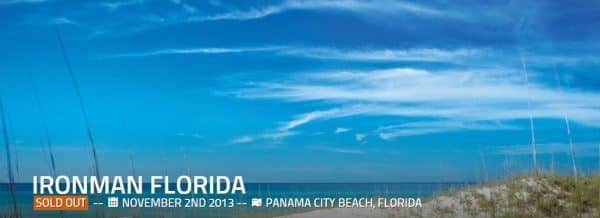
For a long time, it has been called the Granddaddy of all endurance events, the Ironman triathlon. A 2.4-mile swim, 112-mile bike and a 26.2-mile run done consecutively in the same day. Of course, nowadays, double, triple, and even deca Ironman distance triathlons are becoming more and more popular, as well as 24, 48 and even 72-hour mud and obstacle run challenges. If you are calling me crazy for doing my second Ironman, I can introduce you to at least a few people who do challenges that make Ironman look like a game of hopscotch. (Yes, Matt “UltraIronBeast” Dolitsky, you are one of those.)
This competition for me was a learning experience in overcoming obstacles, most of them mental. I did not PR, or even come close, but I now understand completely the quote, “The mind will quite 100 times before the body does.”
Pre-Race

Pete Amedure, Kari Eichen, Kat Ward, Jamie Breibart and myself all decided to drive up Wednesday morning in order to get acclimated to the environment and eliminate and reasons for not being prepared for Saturday’s race. Pete, Kari and I were in my car and had a great time on the way up. Of course, there was a stop at the Huddle House in Perry Florida where we ate and laughed to a point where I spaced out and left my phone, and didn’t realize it until we were half-an-hour from Panama City Beach. It didn’t help that I was in the middle of contracts and had all my recruiters contacting me about interviews and new opportunities. (I ended up remedying this by sending FedEx to the restaurant and delivering it to our hotel. In the meantime, Google Voice was a tremendous help.)
We arrived at the Laketown Wharf complex where we stayed in a luxurious three bedroom, three bath condominium, with a beautiful view of the gulf. I give this hotel/condo complex four stars. It had everything needed including a nightly water and light show that rivals the Bellagio in Las Vegas. Well, not really, but it was a fun amenity. The condos all have a full kitchen, with dishes, glasses, silverware, pots and pans, coffee maker, and a full-size refrigerator. Everything needed for the athlete, and spectathletes, to remove all those pressures of nutrition, and early morning breakfasts. The area also has plenty of great restaurants for good eating as well.
Afterward, we walked the quarter mile to athlete check-in to receive our chip, bibs, bags, and swag. I was a little disappointed in the swag this year. Last year they gave out beautiful TYR transition backpacks, but this year it was a very inferior white backpack that looks like it will fall apart. Jamie’s actually did, so they gave her a replacement immediately. The expo was about twice the size that it was last year, with a host of new vendors. Verizon was displaying their goods, as they were the tracking sponsor this year, along with Newton, Fit2Run, a local bike shop and a bunch of the regulars. Refuel was there, talking about Chocolate Milk, so I did create a video with them talking about the benefits of it. I will share that link on Twitter when I receive it. It should be good for a couple of laughs.
After that, we spent the next couple of days, taking in the aura of Ironman, preparing and eating. Eating was a non-stop event for us. I knew from experience that immense calories were going to be needed in order to be comfortable on the course, so I encouraged our team to keep eating as I did myself.
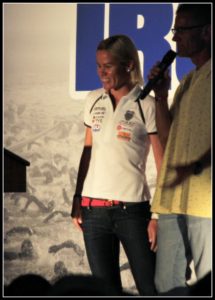 Thursday night was the athlete welcome dinner, and I was almost embarrassed. My recollection of the 2011 athlete dinner was so wonderful, that I really talked it up and encouraged Pete, Jamie, and Kari to come. Jamie decided not to go, but I was so excited for Pete and Kari to be there I couldn’t contain my emotions. Unfortunately, I was sort of let down. It seemed unorganized and hurried. Yes, my favorite pro-triathlete and world champion Mirinda Carfrae was interviewed on stage, so that was great, but the rest of it was about charities and a couple of athletes overcoming their own obstacles. There were video presentations about a woman who was competing for her husband who died the year earlier while training, and a quadriplegic who was competing to show the world that anyone could do anything if they just challenged themselves.
Thursday night was the athlete welcome dinner, and I was almost embarrassed. My recollection of the 2011 athlete dinner was so wonderful, that I really talked it up and encouraged Pete, Jamie, and Kari to come. Jamie decided not to go, but I was so excited for Pete and Kari to be there I couldn’t contain my emotions. Unfortunately, I was sort of let down. It seemed unorganized and hurried. Yes, my favorite pro-triathlete and world champion Mirinda Carfrae was interviewed on stage, so that was great, but the rest of it was about charities and a couple of athletes overcoming their own obstacles. There were video presentations about a woman who was competing for her husband who died the year earlier while training, and a quadriplegic who was competing to show the world that anyone could do anything if they just challenged themselves.
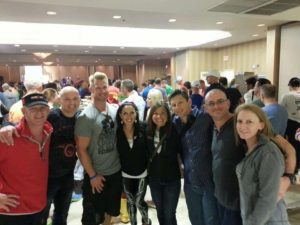 Yes, their stories were inspiring but I just felt like it was too much and way too long. In 2011 the presentations were balanced between the negative and the positive inspiring stories and we even had an athlete briefing by the race director all in the span of 90 minutes. It held the attention of every athlete to a point where the announcer almost didn’t need the microphone. This time, a good portion of the athletes conversed right through all the presentations to a point where it was hard to hear the MC with a microphone. I felt like I let my friend Pete down to a point where I was apologizing so much on the walk back I became annoying. Sorry, Pete and Kari.
Yes, their stories were inspiring but I just felt like it was too much and way too long. In 2011 the presentations were balanced between the negative and the positive inspiring stories and we even had an athlete briefing by the race director all in the span of 90 minutes. It held the attention of every athlete to a point where the announcer almost didn’t need the microphone. This time, a good portion of the athletes conversed right through all the presentations to a point where it was hard to hear the MC with a microphone. I felt like I let my friend Pete down to a point where I was apologizing so much on the walk back I became annoying. Sorry, Pete and Kari.
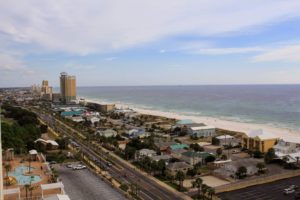 Friday, the anxiety hit like a ton of bricks. You couldn’t cut the tension in the condo with a Ginsu, serrated edge knife. We ate breakfast and then headed down to the beach to get in the water with our wetsuits. The waves sets were barreling to the shore with such force that the red, “no-swimming”, flag was flown, but we knew we needed to at least get in the water for a few minutes just to test out our goggles and our wetsuits. Surprising enough, even with the force of the waves, I thought I became a little more confident. I was able to stay on the surface of the water, and I practiced duck diving through the waves instead of trying to swim over them. I really thought I may have a chance of being faster out of the water than I thought.
Friday, the anxiety hit like a ton of bricks. You couldn’t cut the tension in the condo with a Ginsu, serrated edge knife. We ate breakfast and then headed down to the beach to get in the water with our wetsuits. The waves sets were barreling to the shore with such force that the red, “no-swimming”, flag was flown, but we knew we needed to at least get in the water for a few minutes just to test out our goggles and our wetsuits. Surprising enough, even with the force of the waves, I thought I became a little more confident. I was able to stay on the surface of the water, and I practiced duck diving through the waves instead of trying to swim over them. I really thought I may have a chance of being faster out of the water than I thought.
Afterward, we talked through our transition plans to double check our gear,  checked to make sure our bikes were ready to go and proceeded to transition to check-in everything. We had decided to try and wait out the rain, but unfortunately, I had a phone interview which had the chance of exceeding beyond the time check-in would close, so we walked down in the rain. The line was so long, I was going to be cutting it very close, so afterward, I ran back to the hotel. On the way back, I dropped my phone and cracked the screen. Yes, I had the phone back in my hands all of two hours and I dropped it. I have never broken a phone before, ever, and here I had two phone interviews and I cracked the screen. I was lucky enough that the phone still worked with voice recognition and a little effort, so the two interviews scheduled went off without any problems and I confirmed them both for second interviews as well.
checked to make sure our bikes were ready to go and proceeded to transition to check-in everything. We had decided to try and wait out the rain, but unfortunately, I had a phone interview which had the chance of exceeding beyond the time check-in would close, so we walked down in the rain. The line was so long, I was going to be cutting it very close, so afterward, I ran back to the hotel. On the way back, I dropped my phone and cracked the screen. Yes, I had the phone back in my hands all of two hours and I dropped it. I have never broken a phone before, ever, and here I had two phone interviews and I cracked the screen. I was lucky enough that the phone still worked with voice recognition and a little effort, so the two interviews scheduled went off without any problems and I confirmed them both for second interviews as well.
That night we had a good dinner at the Wicked Wheel and we were all in bed around 9 pm ready to take on the Ironman.
Race Day
As predicted, the night before was restless but I did end up sleeping a good 4-5 hours before the alarm went off. As planned we dressed in sweats, grabbed our “Special Needs” bags, nutrition for the bike, and headed to transition around 4:30 am. We were body marked, checked our bikes, dropped our bags, and then headed back to try and leisurely eat breakfast, and dress for the race. Kari cooked eggs and turkey bacon, I cooked oatmeal and we all hung out for a while and tried to prepare ourselves with our loved ones. It was kind of surreal. I remembered these moments from the first time I competed in this race, but it still seemed like it was all new again.
We dressed, pulled on our wetsuits halfway, hugged and headed for the start line. We walked  with Kari, Kim, and Danny down to the start, but athletes had to enter separately than spectators, so when we finally hit the beach we couldn’t find them. I really wanted to see them all before the start, but I knew I would be ok if I didn’t, but Kari had Pete’s goggles in her bag, so now it became imperative that we find them. We walked over trying to find them, so when it came to a point where we had no time left, we dropped our stuff and proceeded to button up our wetsuits and prepare to go under the arch. It was at that moment, our party found us. Talk about cutting it close. We hugged, gut our well wishes, wished each other luck and headed into the mass of athletes preparing for the start.
with Kari, Kim, and Danny down to the start, but athletes had to enter separately than spectators, so when we finally hit the beach we couldn’t find them. I really wanted to see them all before the start, but I knew I would be ok if I didn’t, but Kari had Pete’s goggles in her bag, so now it became imperative that we find them. We walked over trying to find them, so when it came to a point where we had no time left, we dropped our stuff and proceeded to button up our wetsuits and prepare to go under the arch. It was at that moment, our party found us. Talk about cutting it close. We hugged, gut our well wishes, wished each other luck and headed into the mass of athletes preparing for the start.
This year was a little different as signs were being held up with expected times for the swim. It could be compared to pace groups commonly found in road races except instead of going deep from a start line this went wide along the shore with the idea that if the slower swimmers would be the widest from the buoys and would fall in behind the faster ones. This was thought to bring down the chaos of a mass swim start, but for me, it was worse. I have been in comparable rough water, hit, kicked and swam over before and I always kept on swimming no matter what, but this time I was kicked so many times with the last time throwing my goggles from my face. It took me a few minutes to find them floating away from me, but I was able to put them back without too much trouble.
When I finished my first loop, the clock said 1:11 which was very slow. I thought I should be able to make up at least three minutes on the second loop, so I shouldn’t be in any danger of not making the 2:20 cutoff. I found a rhythm and just kept swimming, but I veered to the left of buoys and to keep correcting my course. When I made the turn for the straightaway to the swim finish, I glanced at my wrist to check my Garmin to see how much time I had left, and it was gone. Not only could I not find out what I needed to cross the swim finish, I wasn’t going to know how fast I would bike, or run. I wouldn’t know when to take my nutrition or even what time it was.
 Three buoys from the end I ended up with a paddle boarder on the left of me and jet ski on the right. The paddleboarder kept yelling the time I had left. “You have 8 minutes. You got this just keep going.” I have to admit, the idea of a DNF crossed my mind and it did not scare me. I thought to myself “would it really be the end o the world.” I would be able to support Pete, Jamie, and Kat and I wouldn’t have to worry about biking 112 miles, chafing, nutrition, none of it. Of course, I wouldn’t get to cross that finish line and I would feel like a failure and that is what really scared me. It wasn’t the disappointment of my friends or even my family, it was the disappointment I would have in myself. That never-ending coulda, woulda, shoulda would really haunt me, so I sped up and went as hard as I could. The waves after the sandbar helped and even though I got caught up in the rope tied to one of the lifeguard’s flotation device I was able to hit the beach at exactly 2:20 getting me over the timing mat at 2:20:08.
Three buoys from the end I ended up with a paddle boarder on the left of me and jet ski on the right. The paddleboarder kept yelling the time I had left. “You have 8 minutes. You got this just keep going.” I have to admit, the idea of a DNF crossed my mind and it did not scare me. I thought to myself “would it really be the end o the world.” I would be able to support Pete, Jamie, and Kat and I wouldn’t have to worry about biking 112 miles, chafing, nutrition, none of it. Of course, I wouldn’t get to cross that finish line and I would feel like a failure and that is what really scared me. It wasn’t the disappointment of my friends or even my family, it was the disappointment I would have in myself. That never-ending coulda, woulda, shoulda would really haunt me, so I sped up and went as hard as I could. The waves after the sandbar helped and even though I got caught up in the rope tied to one of the lifeguard’s flotation device I was able to hit the beach at exactly 2:20 getting me over the timing mat at 2:20:08.
I don’t mind stating that I was exhausted. I have stated it time and time again, that I am not even a good swimmer, but this really put it in perspective.
I ran into transition and the volunteers stated I had eight minutes to cross the bike mat, so they hurried me into my bib and jersey I was using for the bike, put on my helmet and shoes and rushed me out into transition to grab my bike. I crossed and headed out on my 112-mile journey.
My lungs were screaming and my stomach was churning, but I just kept going. I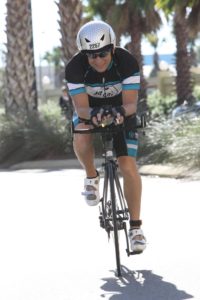 passed the mile 10 marker and about, what I estimate was around the 12-13 mile mark, nausea started. I pulled over to the side of the road and vomited sea water over the guardrail. Unfortunately, I have what is called a vasovagal response to vomiting, which basically means I pass out cold. I woke up, splayed out on the side of the road with the sun shining in my eyes. It took a while to get my wits and balance in order to get back on my bike. I continued slowly with the thoughts of turning around and just ending it. Who would blame me? I became sick on the bike, no one would care. With my stomach still churning and my head spinning I decided I would go to the twenty-mile marker and if I didn’t feel better I would turn around. The earlier thoughts I had of a DNF plagued me again and when I saw the 20-mile sign, I was still feeling sick, but better than I did. I took in some of the Isagenix mix I had in my bottles and decided to go on to the next marker, but it wasn’t more than a mile later I realized that if I turned around at the 30 mile mark, I would have biked 60 miles by the time I got back to the start. That’s when I knew I had it in me. It no longer was about time now it was about finishing.
passed the mile 10 marker and about, what I estimate was around the 12-13 mile mark, nausea started. I pulled over to the side of the road and vomited sea water over the guardrail. Unfortunately, I have what is called a vasovagal response to vomiting, which basically means I pass out cold. I woke up, splayed out on the side of the road with the sun shining in my eyes. It took a while to get my wits and balance in order to get back on my bike. I continued slowly with the thoughts of turning around and just ending it. Who would blame me? I became sick on the bike, no one would care. With my stomach still churning and my head spinning I decided I would go to the twenty-mile marker and if I didn’t feel better I would turn around. The earlier thoughts I had of a DNF plagued me again and when I saw the 20-mile sign, I was still feeling sick, but better than I did. I took in some of the Isagenix mix I had in my bottles and decided to go on to the next marker, but it wasn’t more than a mile later I realized that if I turned around at the 30 mile mark, I would have biked 60 miles by the time I got back to the start. That’s when I knew I had it in me. It no longer was about time now it was about finishing.
From that point on the bike ended up being uneventful. Sure, there were minor challenges. For instance, the wind picked up quite a bit, and of course, I still had no perception of time, except for when I asked, but I just put my head down and kept going.
Here is a little lesson learned while I was on the bike. As I mentioned the wind became a challenge during the bike, but I decided to wear an aero helmet and while I was in aero position and looked down, the wind became a little less a factor. I found myself being able to pick up a higher cadence. The minute I looked straight I could not only hear the wind, but I felt like someone had hit the breaks on my bike. Every article and person always said, one way and the cheapest way to become more aero was a helmet. They were right.
Being the last one out of the water did have one advantage. I wasn’t going to get passed. I was doing all the passing, and with each rider I passed, I felt a little bit of mental boost which helped a great deal. I rolled into transition in a little over 7 hours, which, in my estimation, had me on the side of the road for a little over 30 minutes. All-in-all it wasn’t actually that bad.
A volunteer grabbed my bike, I snatched my run gear bag and was greeted in the changing room by my friend, and client, Hugo Scavino. He helped me rid myself of the bib and bike jersey and don my shoes and hat. After a huge hug, I headed off onto the run course. I stopped briefly for words of encouragement, hugs and kisses from Kim, Kari, Maria and Anne, and off onto the course I went. I walked for about a quarter mile before I started running. I was kind of amazed. I felt like I was able to transition to my running legs a little easier than the Augusta 70.3 I competed in six weeks earlier. I hit the first aid station in about 1.5 miles and I was feeling pretty good. I formulated my plan of running from aid station to aid station and just walking while I was getting water and nutrition. This worked for the first loop.
 Pete and Jaime passed me at my mile 3 and their mile 10 and we shook hands and I motivated Pete with warning him I should not be able to catch him. Of course in the back of my mind, I was questioning if I could somehow make up 7 miles on him. Dave Nardoski caught up with me on his second loop, so I walked and chatted with him for a few minutes before I picked up the pace again. At mile 6 I saw Kat looking really strong and I yelled some encouragement to her as I passed. The halfway point for the first loop is in a park and I was feeling pretty good. I started doing the math in my head for what it would take to catch up to Pete and Jamie. The idea of the three of crossing together seemed surreal but possibly realistic. At mile 10 I saw Jamie and she had picked up the pace from Pete, and she looked really good. Obviously, the three of us crossing was most likely not going to happen unless I could really pick up some speed and Pete and I could catch her. A little while later I saw Pete again walking. We stopped for a minute and he told me that everything hurt. I gave him some encouragement and we parted. Just prior to the turnaround I found myself running next to Lew Hollander. Lew, is an 83-year-old, twenty-time Kona qualifier and finisher. He is extremely inspiring and is the epitome of the idea that age doesn’t have to be an excuse. We chatted briefly, he gave me some motivation, I congratulated him, he ran into the finisher chute and I made the turn. Kim and Danny were on the other side of the turn, so I was able to see them and get some love and hugs from Kim. She actually ran a little bit with me before I headed off.
Pete and Jaime passed me at my mile 3 and their mile 10 and we shook hands and I motivated Pete with warning him I should not be able to catch him. Of course in the back of my mind, I was questioning if I could somehow make up 7 miles on him. Dave Nardoski caught up with me on his second loop, so I walked and chatted with him for a few minutes before I picked up the pace again. At mile 6 I saw Kat looking really strong and I yelled some encouragement to her as I passed. The halfway point for the first loop is in a park and I was feeling pretty good. I started doing the math in my head for what it would take to catch up to Pete and Jamie. The idea of the three of crossing together seemed surreal but possibly realistic. At mile 10 I saw Jamie and she had picked up the pace from Pete, and she looked really good. Obviously, the three of us crossing was most likely not going to happen unless I could really pick up some speed and Pete and I could catch her. A little while later I saw Pete again walking. We stopped for a minute and he told me that everything hurt. I gave him some encouragement and we parted. Just prior to the turnaround I found myself running next to Lew Hollander. Lew, is an 83-year-old, twenty-time Kona qualifier and finisher. He is extremely inspiring and is the epitome of the idea that age doesn’t have to be an excuse. We chatted briefly, he gave me some motivation, I congratulated him, he ran into the finisher chute and I made the turn. Kim and Danny were on the other side of the turn, so I was able to see them and get some love and hugs from Kim. She actually ran a little bit with me before I headed off.
I was hurting now. At mile 14 I slowed to a walk. My feet were screaming in agony, my hips, quads, hamstrings and IT bands were in a lot of pain and I started getting a twinge in my back. I didn’t want to walk, but my legs were not letting me run either. I decided I would walk to the aid station of after mile 15 and continue from there. It didn’t happen the way I wanted. I ended up doing a series of run/walk intervals all the way to mile 18 where Pete and I crossed for the last time. We high-fived each other and continued on. Not too far ahead I stopped to use a portlet, but when I exited I became turned around and stupidly started running in the wrong direction. I caught myself about a half mile before I realized what I was doing and quickly did a one-eighty. I guess I was meant to run even more than a marathon this time.
I did meet Susan, a member of the Sarasota Storm Tri Club, which I have participated in races and training with. We chatted and played cat and mouse for a while. Susan had a very steady pace, so I would catch her and then when I would walk she would pass me. This happened about 3 or 4 times throughout the marathon portion. After getting completing the out-and-back in the park to head to the finish I started to feel like I just was about done with this whole thing. I was walking more than running, I was in pain and I was just ready for this experience to end. When I saw mile 20, I thought I only have a 10k left. I could do a 10k in my sleep. I started to pick up the pace just a bit. I walked through the aid station in between 20 and 21 and started talking to myself. “C’mon legs. Just one more training run. I need ya. Relax. Use gravity as momentum. We can do this.”
Ahead was mile marker 21, and it was then when I decided, there will be no more stops at aid stations, there will be no more walking. It was time to get this done. I picked up the pace and never looked back. I caught up with Susan at mile 22 and I told her to come with me. This was just a 5k with a one-mile warm-up. She said something that really motivated me. “You are really strong, Brad.” Who was she trying to kid? It wasn’t 12 hours ago I had thoughts of quitting. I didn’t quit though and here I was 4 miles from the finish of my second Ironman. I picked up the pace even more to a point where I was running at a sub 8:30 pace for a bit. I was in a lot of pain, but it was going to be worse if I stopped. Every time I passed another athlete or spectator they would say “Good job” and that just fueled me. A couple of the spectators would yell, “Awesome pace keep it up!” I ran through the Tri Club village at 25 when someone yelled “Go Goof GO!”, so I even picked up the pace even more. When I finally reached the chute there were two people running together in front of me and I didn’t know whether to let them go ahead or pass them. I passed them and sped up even more in order to make sure I was alone at the finish line.
I saw the finish line and didn’t even look at the clock. After all, I hadn’t known what time it was up to that point, so what did it matter now. The announcer bellowed, “Brad Minus from Tampa Bay, YOU ARE AN IRONMAN!” Oh, how sweet that sounded. Especially after being kicked, and hit in the water, losing my goggles and Garmin, vomiting and blacking out on the side of the road, and running through all that pain. I finally reached the finish.
A volunteer escorted me to Yvonne Van Vlerken, the women’s first-place finisher, who placed the medal around my neck. We congratulated each other and she gave me a hug, and then I continued with my handler to get a shiny warming sheath, and a finish photo before she handed me off to Kim, Maria, Jamie and the Dannys. I saw Pete sitting down and we just looked at each other with pain on our faces but pride in our eyes.
The rest of the night consisted of pizza and hard cider and regaling stories of the race. PB&J had accomplished what we set out to do a year earlier.
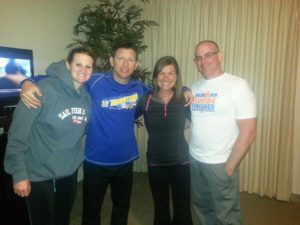 Jamie was the heroine of the night. When she decided to run she end up fast enough to finish with a 13:50. I am still so proud of her. Pete ended up a little under 15 and I ended up with a 15:09. I am not happy with it. It is significantly longer than 2011, but I finished and everything considered, I did have fun. That is what matters most.
Jamie was the heroine of the night. When she decided to run she end up fast enough to finish with a 13:50. I am still so proud of her. Pete ended up a little under 15 and I ended up with a 15:09. I am not happy with it. It is significantly longer than 2011, but I finished and everything considered, I did have fun. That is what matters most.
Thank you to all who tracked and reported on Facebook, for all the prayers, thoughts, motivation and kudos, Anne, Kari, Maria, Hugo and all the other voluneteers, Kim for supporting me and especially to Pete, Jamie, & Kat for being my training buddies through this journey.